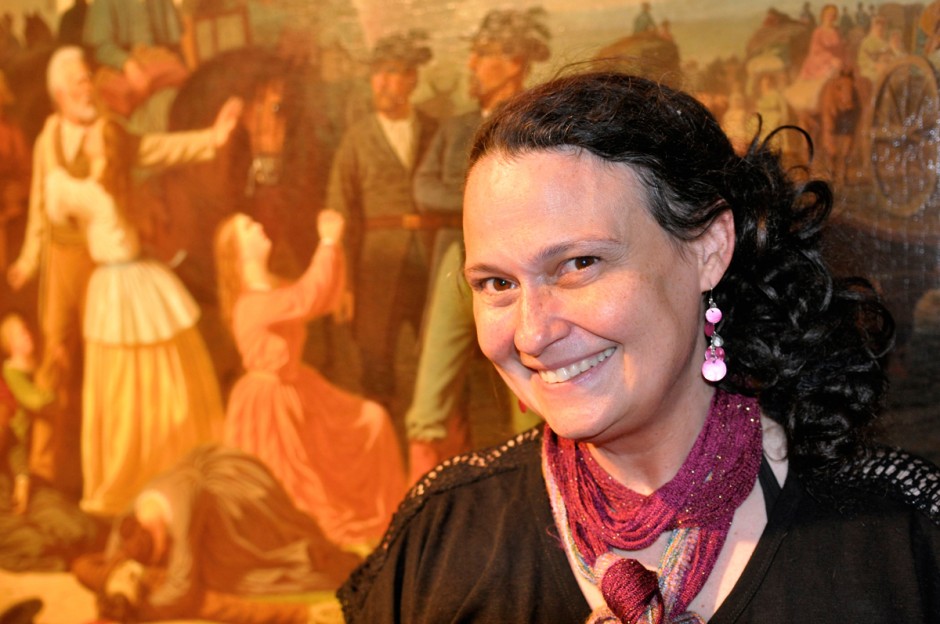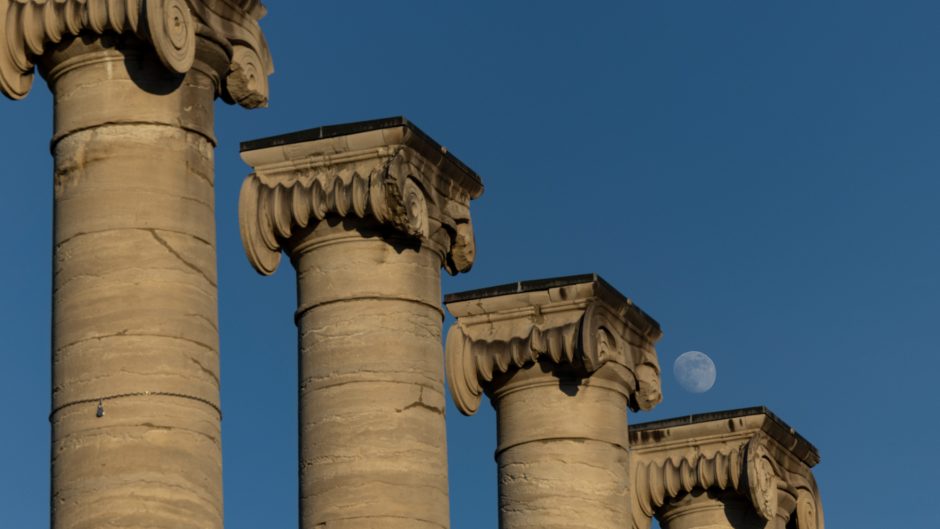
Curator Joan Stack, shown in the gallery in front of Bingham’s Gen. Order No. 11, said the national tours are generating interest in the state society’s collection.
Two traveling art exhibits this year have raised the national profile of the State Historical Society of Missouri. Call it the power of the two B’s: Benton and Bingham.
“There is a growing recognition manifested by these exhibits that these artists are important nationally,” said Joan Stack, art curator of the state society in Ellis Library. “The exhibitions are bringing these artists to a new generation.”
The society’s collection of Thomas Hart Benton consists of 10 large egg tempera paintings, more than 100 lithographs, and about 200 watercolors and drawings illustrating Mark Twain adventures.
Four of the paintings and seven of the lithographs are part of the traveling retrospective “American Epics: Thomas Hart Benton and Hollywood.” The show ran from June 6 to Sept. 7 at the Peabody Essex Museum in Salem, Massachusetts. From Oct. 10 to Jan. 3, 2016, it will be at the Nelson Atkins Museum of Art in Kansas City. From there it heads to the Amon Carter Museum of American Art in Fort Worth, Texas, and the Milwaukee Art Museum in Wisconsin.
The society’s collection of George Caleb Bingham is one of the largest in the country and includes two of his most famous paintings, Gen. Order No. 11 and Watching the Cargo.
Four Binghams from the Missouri collection, including Watching the Cargo, which depicts river men guarding steamboat goods, are part of the show “Navigating the West: George Caleb Bingham and the River.” It opened at Amon Carter in 2014, moved to the St. Louis Art Museum in early 2015 and is on view through Sept. 20 at the Metropolitan Museum of Art in New York.
Society art has toured in the past, but this is the first time that two major national tours have simultaneously included Bentons and Binghams from the collection.
The Two B’s
Born in Neosho, Missouri, Benton (1889–1975) is best known for leading the Regionalist Movement, which emphasized representation at a time when much of the art community was in love with abstraction. But Regionalism is not realism. The works in the genre tend to be stylized. Many are emotive and make subtle social commentary. Benton is well known for his works involving World War II, which shows cartoonish figures in a ghoulish world of death and destruction.
Bingham (1811–1879) grew up in Franklin, Missouri. A self-taught artist, he is most famous for his representations of life on the Missouri and Mississippi Rivers. Earlier this year, the historical society acquired a lithograph of Bingham’s “The Emigration of Daniel Boone.” The acquisition completed the society’s collection of Bingham prints.
Why the sudden interest in Missouri artists?
Stack speculated that it might be due to the artists’ cultural perspective. “There is something about being from Missouri, at the center of the nation and the crossroads between east and west, north and south, that gives Missouri artists an understanding of the nation that artists from other American regions may not have,” she said.
New Building Planned
Along with receiving national exposure, the State Historical Society of Missouri has other reasons to be excited. A new building is being planned with a projected opening in 2019, said communication strategist Mary Ellen Lohmann.
The museum and research center will be at Sixth and Elm Streets. The entire first floor of the projected three-story building will be devoted to displays. Gallery space is expected to increase threefold. Currently, there is room to show only a quarter of 1 percent of the state society’s collection, Lohmann said.
“We will be more accessible to the community, giving Missourians a chance to view their treasures,” she said.




![062625_CEI Aerial View_email-cropped[29] (1)](https://showme.missouri.edu/wp-content/uploads/2025/06/062625_CEI-Aerial-View_email-cropped29-1-940x529.jpg)